When Women March - Boston’s Great Suffrage Parades of 1914 & 1915
Introduction
Text-to-speech Audio
“Two of the most effective bits of propaganda of the referendum campaign were the two great parades held in Boston in 1914 and ‘15. [...] Just why seeing women walk down the street in parade should convince men to vote for suffrage is a mystery, but it did so by the thousands. Probably because it gave them visual proof that the women who wanted suffrage were ordinary representative women - homemakers, mothers, daughters, teachers, working women - and not the unsexed freaks the antis declared they were.”3 Florence Hope Luscomb (MIT 1909 S.B. Architecture)
Images
Votes for Women Button
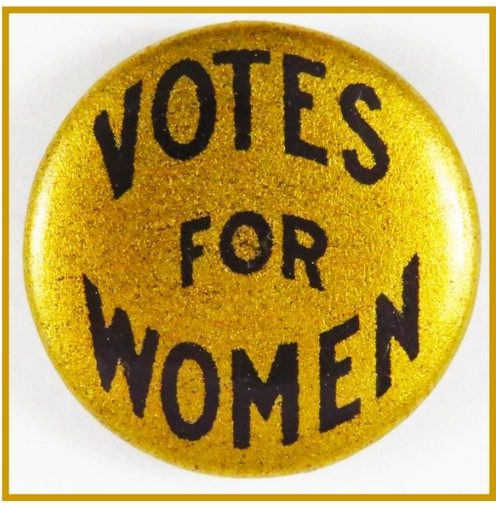
1914: The May 2 Button, manufactured by Lopez Brothers of School Street in Boston issued for the Boston Parade.
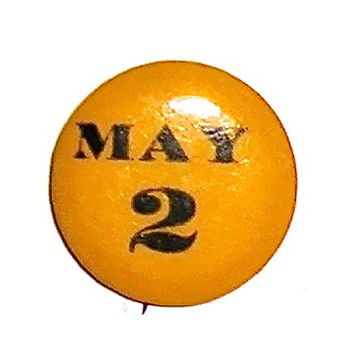
1914: Three women standing in front of the parade headquarters of the Massachusetts Woman Suffrage Association.
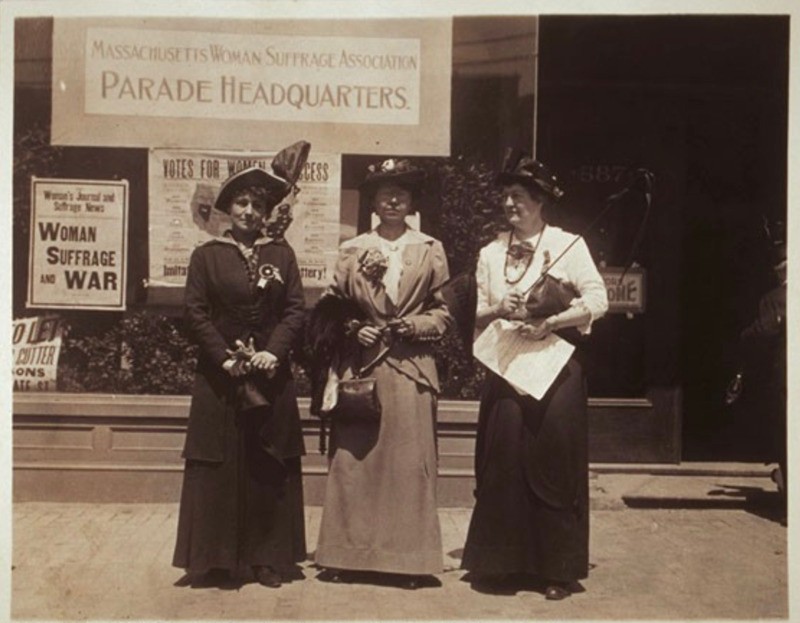
1914 Massachusetts Suffrage Parade Flyer
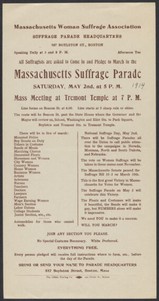
1914 Parade Plan and Instructions to Marchers
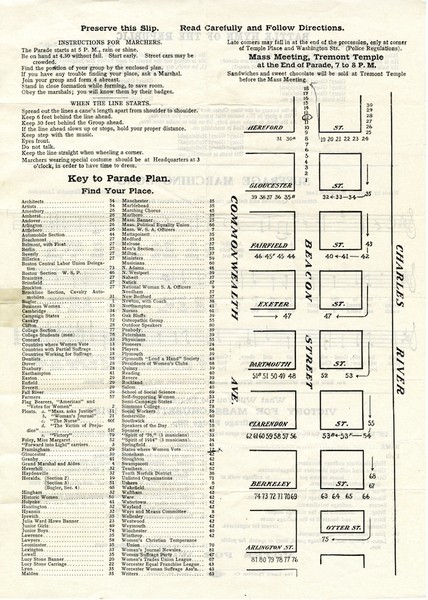
1914 Front page of the Boston Globe: Woman Give Great Parade
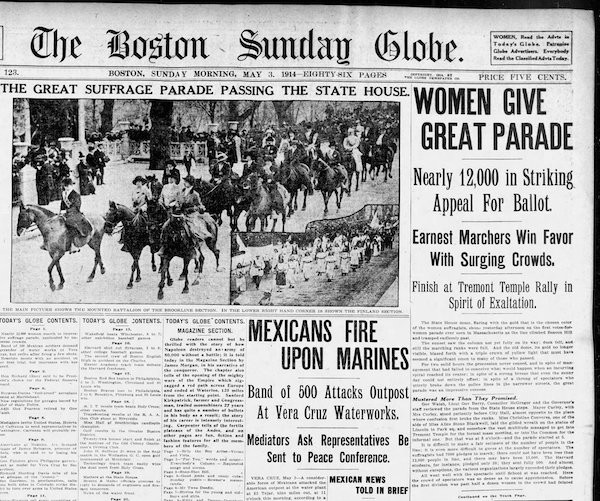
Suffrage victory parade, all friends invited to to march, October 16, 1915, Boston
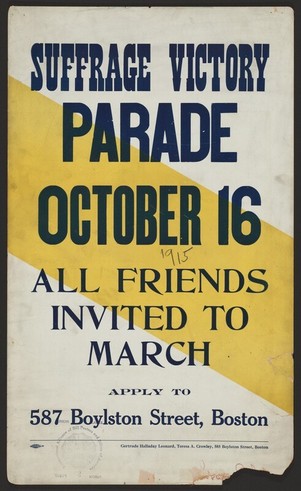
1915 Massachusetts Woman Suffrage Victory Parade: Instructions for Marcher
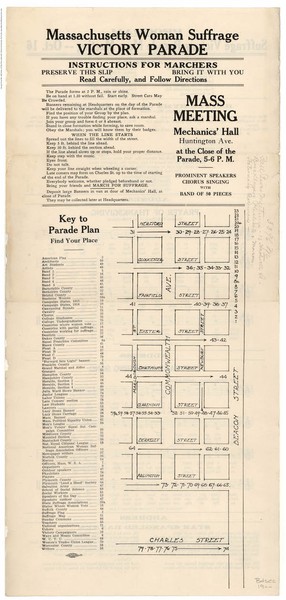
1915 Front page of the Boston Globe: Suffrage Victory Parade Sets a Record for Enthusiasm - Nearly 9000 in the Line
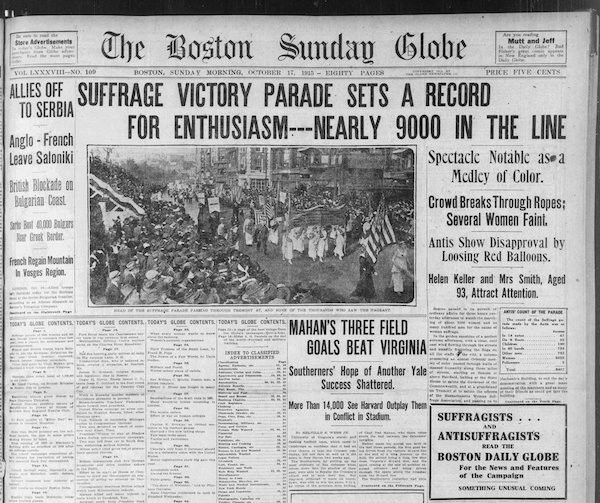
Backstory and Context
Text-to-speech Audio
In May 1913, the Massachusetts Woman Suffrage Association (MWSA) voted to sponsor their first parade the following year: “There was much doubt of the propriety of this but when a rising vote of the women present was taken [...] almost the whole convention rose.”7 Initially planned for May 16th, 1914, MWSA moved its parade to May 2nd to support the National Woman Suffrage Association’s (NWSA) Women’s Independence Day campaign.2
In early 1914, Dr. Anna Howard Shaw had petitioned President Woodrow Wilson to proclaim the first Saturday in May as Women’s Independence Day in “recognition of the loyalty of American women to the spirit and claims of 1776, that the foundation of all just governments rests upon the consent of the governed.”5 President Wilson signed a Congressional Resolution establishing that the second Sunday in May would be “Mother’s Day” - a woman’s place in the home.6
Planned by Gertrude Halladay Leonard, Mary Hutcheson Page (MIT Class of 1888), and Grace A. Johnson, the Boston parade was a grand spectacle. It brought together 12,000 suffragists from New England suffrage groups, “self-supporting” women, and men and women from Massachusetts colleges - including MIT. The marchers, accompanied by a marching choir, started at Massachusetts Avenue, progressed to the State House along Beacon Street, then spiraled right on School Street, Washington Street, Eliot Street, and Tremont Street to finish at Tremont Temple for a post-parade rally.7,16
Katharine Dexter McCormick (MIT 1904 S.B. Biology) spoke at Tremont Temple that evening: “The first suffrage parade marks an epoch in the life of the individual and in the life of the city. With the individual it marks the moment when she comes face to face with her own spirit and determination. With the people of the city seeing is believing. They cannot look into the faces and see the enthusiasm on those faces and the inspiration without realizing they are face to face with a deep moral issue, and that however slowly it may come its triumph is certain and sure. We and our cause have entered the noble realm of practical politics and who shall say we have not the brains and temper to master that realm and to prove that nothing is foreign to us.”8
Following the rally, 1000 overflow participants, two-thirds men, joined Florence Luscomb and Margaret Foley on the common. Florence declared, “[Our] parade demonstrated the falsity of the claim that women cannot stand together.” The suffragists’ display of unity and solidarity, a powerful testament to their shared cause, was a sight to behold.10 According to the Boston Globe, “Each woman was there for a purpose, and that was to show the seriousness of the woman’s suffrage movement. [...] The women marched to win.”16
The years of petitions, hearings, open-air meetings, and parades finally led to a breakthrough. On February 17th, 1915, the Massachusetts Legislature passed the Woman Suffrage Amendment by a vote of 193 to 36, granting women the right to vote in Massachusetts. Mary Hutcheson Page declared, “After 60 years of stubborn resistance, the Massachusetts Legislature has at last yielded to the demands of the Suffragists, and now women are permitted to win their right to citizenship if they can, by appealing to each male voter of the State. Truly no cause but ours could win against such overwhelming odds, for what amendment to the Constitution can we conceive would pass if all those who [were] most vitally concerned in it were just those who are not permitted to vote on it? And yet we expect to win.”4 To celebrate this victory, the suffragists marched down Tremont Street to Boylston Street, passing through MIT’s Campus, to MWSA Headquarters on Boylston Street.
As part of the final push to the November 2nd referendum, the Votes for Women Victory Campaign organized a “whirlwind tour of all the towns in the Eastern and Western sections of the State”1 to begin in May and continue through Election Day. Florence Luscomb, recognized as one of the MWSA’s most influential speakers, would lead the Western Division.13 They also arranged a parade and a rally for October 16th. Most 1914 parade organizers, including the MIT Alumnae, returned to help with the “Victory Parade.”
Like the previous year’s event, the Victory Parade began at the corner of Mass. Avenue and Beacon Street, following the same route to the State House. However, instead of spiraling inward, the parade turned down Tremont Street to Huntington Avenue via Saint James Avenue, ending at Mechanics Hall for a pro-suffrage rally.11 The event at Mechanics Hall numbered 8,000 supporters, with an additional 2000 gathered outside. “[W]hen the Tech boys and the Harvard contingent arrived they would be heard as well as seen and they gave their ‘yells’ which terminated with ‘Suffrage, suffrage, suffrage!’ and everyone stood up and applauded.”15 According to the Woman’s Journal, organizers predicted the post-parade rally would be “the greatest rally for equal suffrage ever held in Massachusetts.”18
Boston Voter registrations soared to 114,224 leading up to the referendum, breaking the previous record of 114,217 set in 1904.12 Unfortunately, the November 2nd, 1915 referendum for women’s suffrage failed by a 2 to 1 margin. The MWSA pivoted to support the amendment to the U.S. Constitution.
Cite This Entry
Smith, Coleen. "When Women March - Boston’s Great Suffrage Parades of 1914 & 1915." Clio: Your Guide to History. August 26, 2024. Accessed April 11, 2025. https://theclio.com/entry/181473
Sources
- “Arranging for Suffrage Parade.” The Boston Globe, 26 Sept. 1915.
- “Bay State Men Open Quarters.” Woman’s Journal, Vol. 45, No. 5, 31 Jan. 1914. Schlesinger Library on the History of Women in America, Harvard University, https://nrs.lib.harvard.edu/urn-3:rad.schl:26312858?n=45.
- Cantarow, Ellen, Susan Gusbee O’Malley, and Sharon Hartman Strom. Moving the Mountain. Feminist Press at CUNY, 1980.
- “Demonstration Defended.” The Boston Globe, 17 Feb. 1915, p. 10.
- “Dr. Shaw Urges National Day.” Woman’s Journal, Vol 45, No. 13, 28 Mar. 1914. Schlesinger Library on the History of Women in America, Harvard University, https://nrs.lib.harvard.edu/urn-3:rad.schl:26312858?n=105.
- Hamlin, Kimberly A. “Women Asked for an Independence Day. They Got Mother’s Day Instead. - The Washington Post.” Washington Post, The Washington Post, 7 May 2021, https://www.washingtonpost.com/outlook/2021/05/07/women-asked-an-independence-day-they-got-mothers-day-instead/.
- Harper, Ida Husted, editor. “ The History of Woman Suffrage, Volume VI, 1900-1920.” The Project Gutenberg EBooks, National American Woman Suffrage Association, 1922, https://www.gutenberg.org/cache/epub/30051/pg30051-images.html.
- “Like a Jubilation.” The Boston Globe, 3 May 1914, p. 11.
- “Maud Malone: The New York City Suffrage Parade of 1908 (U.S. National Park Service).” NPS.Gov Homepage (U.S. National Park Service), https://www.nps.gov/articles/maud-malone-the-new-york-city-suffrage-parade-of-1908.htm. Accessed 14 Mar. 2024.
- “Meeting on the Common.” The Boston Globe, 3 May 1914, p. 11.
- “Object of the Month.” “A Rash and Dreadful Act for a Woman”: The 1915 Woman Suffrage Parade in Boston, Massachusetts Historical Society, July 2010, https://www.masshist.org/object-of-the-month/objects/a-rash-and-dreadful-act-for-a-woman-2010-07-01.
- “Record Interest Shown in Boston.” Woman’s Journal, Vol. 46, No. 43, 23 Oct. 1915. Schlesinger Library on the History of Women in America, Harvard University, https://nrs.lib.harvard.edu/urn-3:rad.schl:26312859?n=364.
- Strom, Sharon Hartman. Political Woman. Temple University Press, 2001, p. 87.
- “Suffrage Parade Sets Record.” The Boston Globe, 17 Oct. 1915.
- “The Men in the Parade.” The Boston Globe, 17 Oct. 1915, p. 11.
- “When Women March.” The Boston Globe, 4 May 1914.
- “Women Give Great Parade.” The Boston Globe, 3 May 1914, pp. 1 & 10.
- “Women Watch at Massachusetts Polls.” Woman’s Journal, Vol. 46, No. 39, 25 Sept. 1915. Schlesinger Library on the History of Women in America, Harvard University, https://nrs.lib.harvard.edu/urn-3:rad.schl:26312859?n=314.
1. “Special Guest Blog: Woman’s Suffrage Buttons | Busy Beaver Button Museum.” Home | Busy Beaver Button Museum, https://www.buttonmuseum.org/index.php/blog/special-guest-blog-womans-suffrage-buttons. Accessed 5 Feb. 2024.
2. Woman's Suffrage Buttons, Woman Suffrage Memorabilia, http://womansuffragememorabilia.com/woman-suffrage-memorabilia/suffrage-buttons
3. Courtesy of the Schlesinger Library on the History of Women in America, Radcliffe Institute WRC-Jo5-13. http://id.lib.harvard.edu/images/olvwork20003654/catalog.
4. 1914 Flyer. Courtesy of the Schlesinger Library on the History of Women in America, Harvard University. https://nrs.lib.harvard.edu/urn-3:rad.schl:39990765?n=15.
5. 1914 Parade Plan. Simmons University, https://beatleyweb.simmons.edu/suffrage/exhibits/show/simmons-university-and-the-suf/item/40
6. "Woman Give Great Parade."The Boston Globe, 3 May 1914
7. Suffrage victory parade - Schlesinger Library & Suffrage at Simmons, https://beatleyweb.simmons.edu/suffrage/items/show/42.
8. 1915 Instructions for Marcher. Massachusetts Historical Society. https://www.masshist.org/database/viewer.php?item_id=1892&mode=large&img_step=1&&pid=3&ft=Object%20of%20the%20Month&nodesc=1.
9. “Suffrage Parade Sets Record.” The Boston Globe, 17 Oct. 1915.

